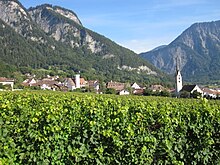Maienfeld district
| Maienfeld | |
|---|---|

|
|
| Basic data | |
| Canton : | Graubünden (GR) |
| District : | Landquart |
| Main town : | Maienfeld |
| Surface: | 74.21 km² |
| Residents: | 6252 December 31, 2009 |
| Population density : | 84 inhabitants per km² |
| map | |
The Maienfeld district - or the historical, popular name Bündner Herrschaft ( Rhaeto-Romanic Signuradi ) - formed the northern of the two districts of the Landquart district in the canton of Graubünden until December 31, 2015 . At the end of December 2009, the Maienfeld district had 6252 inhabitants. The main town is the historic town of Maienfeld . The districts were abolished by the Graubünden regional reform.
geography
The Bündner Herrschaft forms the northernmost part of the canton of Graubünden in the Chur Rhine Valley and lies on the right bank of the Rhine between the Landquart in the south, the Rhine and the St. Galler Oberland with Bad Ragaz in the west, the Rätikon with Vilan and Falknis in the east and the St. Luzisteig and Liechtenstein with Balzers in the north. The Bündner Herrschaft is the largest wine-growing region in Graubünden with a favorable climate.
traffic
In terms of transport, it is connected to the Chur-Zurich and Chur-St. Gallen the SBB with train station in Maienfeld , the line Chur-Landquart-Klosters-Davos of the Rhaetian Railway with train station in Malans as well as through the autobahn A13 with exit in Bad Ragaz (for Fläsch), Maienfeld (for Maienfeld and Jenins) and Landquart (for Malans).
Communities
The Bündner Herrschaft or the district of Maienfeld comprised four communities (as of December 31, 2015):
| coat of arms | Name of the parish | Population (December 31, 2015) |
Area in km² |
BFS no |
|---|---|---|---|---|
| Bottle | 799 | 19.94 | 3951 | |
| Jenins | 886 | 10.54 | 3952 | |
| Maienfeld | 2945 | 32.33 | 3953 | |
| Malans | 2379 | 11.40 | 3954 |
history
The name Bündner Herrschaft, which is still in use today for the former district, derives from the time when the courts of Maienfeld and Malans were subject to the three groups of the Gray Bund , the Church of God and the Ten Court . As part of the ten-court federation, the "rulers" were both ruled and dominant. As a result of the mediation act in 1803, the former rule became a free high court of the Canton of Graubünden. From 1851 to 2000 it continued to exist as the Unterlandquart district and since 2000 as the Maienfeld district in the Landquart district. The area has belonged to the Landquart region since January 1, 2016 .
language
The communities changed in the late Middle Ages by the alträtoromanischen language Alemannic dialects , the dialect of Jenin High Alemannic German is sometimes the dialects of other communities as bodenseealemannisch apply. The language change was initiated from the north through the Rhine valley and was not influenced by the Walsers who lived in the 13th / 14th centuries. In the 19th century , neighboring areas such as the Prättigau, bordering to the east, with its clearly different High Alemannic dialects, came from Valais . The former Walser settlements of the Bündner Herrschaft (including Sturfis , Guscha ) have hardly left any traces in today's dialects. A dialect grammar was dedicated to the Alemannic dialect of the rule in the early 20th century. In the linguistic atlas of German-speaking Switzerland , the rule is represented by the places Fläsch (GR1), Jenins (GR2) and Malans (GR3). In Maienfeld (GR1a), data was not collected consistently, but only in individual cases.
Press
Regional newspaper is the Prättigauer and Herrschäftler . The national media are Die Südostschweiz and Bündner Tagblatt .
Bündner Herrschaft above Maienfeld , looking south
Bündner Herrschaft to the north. Landquart on the left
Bündner Herrschaft around 1830, drawing by Elias Emanuel Schaffner (1810–1856). Landquart in the foreground, Malan in the middle
economy
The Bündner Herrschaft is a Swiss wine-growing region . Viticulture plays an important role here and is a large industry. The winery at Schloss Salenegg in Maienfeld is considered the oldest still existing winery in Europe. The other villages of the estate are also known for their viticulture. The Bündner Weinwanderweg leads through all four villages in this region and the Graubünden tourism association writes "Bündner Herrschaft - the small region of great wines". Another economic factor in the region is tourism. Tourists from all over the world come to rule because Maienfeld is considered the hometown of the fictional character Heidi .
Web links
- Official website of the Maienfeld district
- Adolf Collenberg: Maienfeld (rule). In: Historical Lexicon of Switzerland .
Individual evidence
- ↑ Paul Meinherz: The dialect of the Bündner Herrschaft. Huber, Frauenfeld 1920 (contributions to Swiss German grammar XIII).
- ↑ The future is origins under Castle Stories on the Salenegg Castle website
- ↑ Bündner Herrschaft - the small region of great wines on graubuenden.ch





